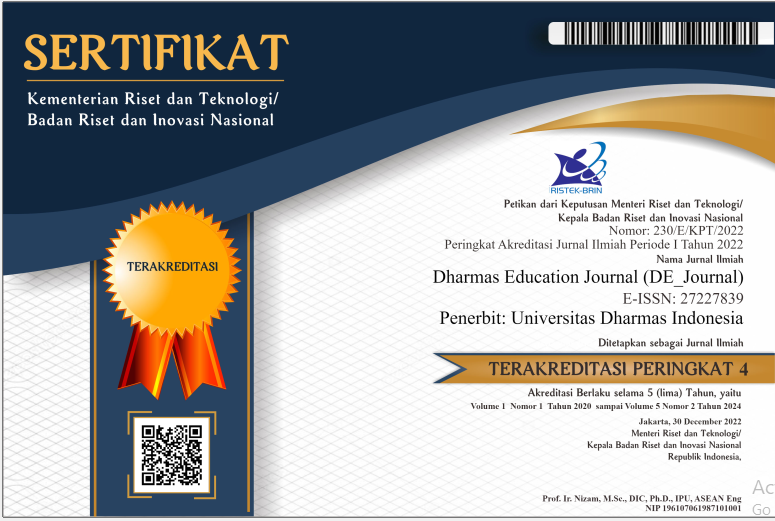STUDI LITERATUR - SCAFFOLDING DENGAN METODE DEFRAGMENTING STRUKTUR BERPIKIR MASALAH HOTS
DOI:
https://doi.org/10.56667/dejournal.v5i1.1196Keywords:
Scaffolding, HOTS, Defragmenting, Mathematics LearningAbstract
Many studies have discussed the HOTS problem. Theories such as Vygotsky's scaffolding concept, where someone will be able to achieve understanding with guidance from someone who understands better, as well as the concept of defragmenting, where by breaking down the structure of thinking from understanding the problem to solving the problem, someone can have their thinking ability facilitated, especially the ability to high level thinking or HOTS. Therefore, it is necessary to analyze these concepts to study scaffolding with the defragmenting method in HOTS problems. This research uses a literature study method to examine how the scaffolding approach with the method of defragmenting thinking structures can support students in understanding HOTS in mathematics. The main focus of this research is to examine: (1) The role of scaffolding in solving HOTS mathematics problems; (2) Scaffolding concept using the method of defragmenting thinking structures; and (3) Learning characteristics that apply this method. The main finding of this literature study states that mathematics anxiety is the main obstacle in students' understanding of HOTS. However, with a scaffolding and defragmenting approach, students can break down problems into smaller parts, facilitate understanding, and improve skills in HOTS. Thus, it can be concluded that the scaffolding approach using the defragmenting method has great potential to improve students' understanding of complex mathematical problems. The implications for this literature study lead to developing a learning program that uses scaffolding with the defragmenting method to facilitate HOTS.
Downloads
References
Albab, U., Budiyono, and D. Indriati. 2020. “Metacognition Skills and Higher Order Thinking Skills (HOTS) in Mathematics.” in Journal of Physics: Conference Series2.
Anghileri, Julia. 2006. “Scaffolding Practices That Enhance Mathematics Learning Julia Anghileri University of Cambridge.” Mathematics Learning 10(2):1–16.
Badjeber, Rafiq, and Jayanti Putri Purwaningrum. 2018. “Pengembangan Higher Order Thinking Skills Dalam Pembelajaran Matematika Di SMP.” Guru Tua : Jurnal Pendidikan Dan Pembelajaran 1(1):36–43.
Gusdinata, Jeki, and Somakim. 2019. “The Development of Mathematics HOTS Problems on Trigonometric for Senior High School.” in International Conference on Progressive Education.
Hasim, Salbiah binti Mohamad, Ruhizan binti Mohamad Yasin, and Roslinda binti Rosli. 2016. “A Meta Analysis Study On The Effectiveness of Higher Order Thinking Skills (HOTS) Based Learning in Science and Mathematics Subjects.” in In Proceeding 7th International Seminar on Regional Education.
Kartiningrum, Eka Diah. 2015. Panduan Penyusunan Studi Literatur.
Lestari, Siti Rohmi Yuliati, and Ika Lestari. 2018. “HIGHER-ORDER THINKING SKILLS (HOTS) ANALYSIS OF STUDENTS IN SOLVING HOTS QUESTION IN HIGHER EDUCATION.” PERSPEKTIF Ilmu Pendidikan 32(2):181–88.
Ma’rufi, M. Ilyas, and R. F. Pasandaran. 2020. “Higher Order Thinking Skills (HOTS) First Middle School of Class Viii Students in Completing the Problem of Polyhedron.” in Journal of Physics: Conference Series.
Pratama, G. S., and H. Retnawati. 2018. “Urgency of Higher Order Thinking Skills (HOTS) Content Analysis in Mathematics Textbook.” P. 8 in Journal of Physics: Conference Series. Vol. 1097.
Salsabila, Fathiya, R. Johar, and Bahrun. 2018. “Students’ Difficulties in Solving Higher Order Thinking Skills Problems on Algebra Content.” in Proceedings of AICS-Social Sciences.
Sofiatun, Siti, Pinta Deniyanti Sampoerna, and Lukman El Hakim. 2018. “The Effect of Scaffolding Techniques on the Ability of Student’s Reasoning Ability and Mathematics Anxiety Reviewed from Gender.” UNNES Journal of Mathematics Education 7(1):63–71.
Sukendra, I. K. 2020. “Developing Teaching Materials for Trigonometry in Mathematics with Realistic Orientation Using HOTS Questions.” in Journal of Physics: Conference Series2.
Wulandari, Luthfiyanti Putri, and Rini Setianingsih. 2018. “THE GIVING OF SCAFFOLDING TO OVERCOME JUNIOR HIGH SCHOOL STUDENTS’ DIFFICULTIES IN SOLVING HIGHER ORDER THINKING PROBLEMS OF ALGEBRA.” MATHEdunesa 1(7):46–50.
Wulandari, S., and M. U. Gusteti. 2021. “Defragmentation of Preservice Teacher’s Thinking Structures in Solving Higher Order Mathematics Problem.” Pp. 1–9 in ICOMSET 2020. Vol. 1940.
Wulandari, Suci, Sri Novia Martin, and Widdya Rahmalina. 2022. “ANALISIS PROSES BERPIKIR MAHASISWA DENGAN KECEMASAN TERHADAP MASALAH MATEMATIKA HOTS BERDASARKAN FASE KERJA MASON.” De Fermat 5(2):120–35.
Zulfa, H., D. R. S. Saputro, and Riyadi. 2018. “Analysis of Difficulties in Mathematics Learning on Students with Deictic Gesture Type in Problem-Solving HOTS Algebra Test.” in Journal of Physics: Conference Series.
Zulfa, H., D. R. S. Saputro, and Riyadi. 2019. “Students’ Difficulties in Mathematics Learning with Artisan Character Type in HOTS Trigonometry Test.” in Journal of Physics: Conference Series.
Downloads
Published
How to Cite
Issue
Section
License
Copyright (c) 2024 Dharmas Education Journal (DE_Journal)

This work is licensed under a Creative Commons Attribution-NonCommercial-NoDerivatives 4.0 International License.
Makalah yang disampaikan diasumsikan tidak mengandung bahan propietary yang tidak dilindungi oleh hak paten














